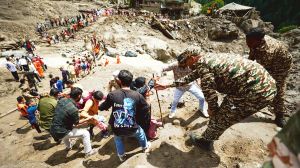Aboard the Maharaja with JRD Tata
The airline began its journey in the early 1930s when on October 15, 1932 JRD Tata piloted single-engine De Havilland Puss Moth on its maiden flight from Karachi to Bombay with loads of mail.
 JRD Tata, the founder of Tata Airlines. (Image: Tata Sons)
JRD Tata, the founder of Tata Airlines. (Image: Tata Sons)(Written by RK Saboo)
I remember in 1960 I used to visit London frequently and the cynosure of all eyes was the big boarding of Air India at the Piccadilly Square with “Maharaja” emblazoned in bold. The Air India helmed by JRD Tata was then a premier airline of the world with the first Boeing 707 flight in Asia.
It had started off as Tata Airlines in 1932. Now after 99 years, from 1932 to 2021, it’s come a full circle to the Tatas.
🗞️ Subscribe Now: Get Express Premium to access the best Election reporting and analysis 🗞️
Once when I was going to London on Boeing 707, with my seat in the third row from the front, I saw JRD Tata across the aisle in the fourth row. Those days there were only two sections — economy and first class, there was no business class. JRD, though Chairman of Air India, had no paraphernalia around him and received no special attention. I observed that after a while he sauntered off to the economy class. Out of curiosity I asked the stewardess about him and she suggested that i should peep into the economy class. I saw he was sitting next to a passenger and was in an animated conversation with him. He continued his tête-à-tête for twenty minutes or so. On his return I asked him whether I could sit next to him. He readily agreed and i asked him about his foray into the economy class. He smiled and said, “I get the real feedback about Air India service from the economy class passengers, not the first class ones”. What a vision, what an understanding. It was a lesson I never forgot.
The airline began its journey in the early 1930s when on October 15, 1932 JRD Tata piloted single-engine De Havilland Puss Moth on its maiden flight from Karachi to Bombay with loads of mail. Tata Air Service was a small team that soon grew to become Air India and Air-India International.‘Maharaja’ was the creation of Bobby Kooka, one of the first employees of the Tata Airlines.
A perfectionist, JRD Tata sought the highest standards, be it in the operation or maintenance of the AI fleet. He was equally uncompromising about the standard of service to passengers.
Soon AI with its 400-seater Boeing 747s began to be regarded as one of the best airlines of the world.
It was thanks mainly to JRD Tata who handpicked the best talent from all over the world.
His spirit of fair play and justice was legendary. In 1930, Aga Khan announced a prize of £500 for the first Indian to fly solo from India to England or vice versa within six weeks. Then 26, JRD Tata, who had a flying license, started from Karachi in a Gipsy Moth. Meanwhile, Aspy Engineer, then 19, started the journey from London. Due to bad weather JRD had to land at Alexandria where he saw another Gipsy Moth. He found that it belonged to Aspy Engineer who needed a spark plug. JRD immediately gave him a spare one that he had. Thanks to him, Engineer was able to reach Karachi two and half hours before JRD and bag the prize.
But JRD never grudged him the prize. While Engineer went on to become India’s second Chief of Air Staff, Tata became the chairman of Air India.
After independence, India nationalized all Indian airlines in 1953, creating two corporations – domestic services under Indian Airlines and international services under Air India. This was done to take advantage of the increase in air travellers. Unfortunately, these enterprises began to incur losses. Private airlines entered the country after liberalization in 1991, and gave a stiff competition to the Indian Airlines and Air India. The two public airlines merged in 2007 under Air India but the move made no difference to its profits.
In 2009, my wife suffered a knee injury in Birmingham and had to return to Delhi. I purchased first class tickets on Air India and we drove directly to the Heathrow airport. On the flight, the footrest was not functioning. To keep the leg horizontally, the stewards had to put some boxes under the footrest, which made it an unpleasant experience.
Merging the two airlines did not make things better. Neither the bureaucracy nor the pilots appeared to be committed to the airline and there was rampant nepotism in upgrading from economy to business or first class, and other concessions.
Most major airlines worldwide have been privatized and finally the Indian government also decided to sell off Air India. In 2018, it had offered to sell 76% of its stake but found no taker. In 2020, it approved the sale of 100% stake and Tata’s bid was accepted through a holding company. Finally, the Air India was back with the Tata’s after 50 years.
In an emotional message, former chairman Ratan Tata said, “The Tata group winning the bid for air India is great news! While admittedly it will take considerable effort to rebuild Air India, it will hopefully provide a very strong market opportunity to the Tata group in the aviation industry.
On an emotional note, Air India, under the leadership of Mr JRD Tata had, at one time, gained the reputation of being one of the most prestigious Airlines in the world. Tatas will have the opportunity of regaining the image and reputation it enjoyed in earlier years. Mr JRD Tata would have been overjoyed if he was in our midst today.”
I have full faith that Air India in its new avatar will once again go on to become one of the best airlines of the world.
(The writer was the first Indian to be elected president of Rotary International)







